
| The Comptroller's Report |
Nancy Wyman - State Comptroller
|
Connecticut's Financial Position:
From Deficit to Surplus and Back Again
Connecticut state government uses two different accounting methods to assess
and report its fiscal condition. One method is referred to as Generally Accepted
Accounting Principles (GAAP); the other is known as modified cash accounting.
GAAP, as the name implies, is the recognized standard for accurate financial
reporting. Corporate financial reports that many readers are familiar with are
based on GAAP.
Connecticut state government has not yet adopted GAAP for budget or financial
control purposes. Instead the state uses the modified cash system to prepare the
budget and to control and report spending and receipts through the year.
The state's fiscal condition under modified cash accounting is dependent on
relatively unsystematic timing of payments and posting of receipts. GAAP
utilizes more rigid standards on when to post expenditures and record revenue.
Therefore, GAAP provides a more consistent and reliable method for reporting and
analyzing state financial data. Accordingly, the fiscal data that follows is
presented on a GAAP basis.
Because the state budget is presently based on modified cash accounting, the
media tends to report the state's position on this cash basis. Therefore, the
GAAP numbers that follow may surprise some readers.
Fiscal Year 2001 General Fund Performance -
Operating Results for One State
Fund in a Single Fiscal Year (July 1, 2000 - June 30, 2001)
- The General Fund is the state's largest single operating fund. Most state
programs and revenues are accounted for within the General Fund. Almost 90
percent of all state operating expenses are within this single fund.
- In Fiscal Year 2001, the state recorded a General Fund surplus of $13
million with revenues totaling $13.066 billion and expenditures of $13.053
billion. The surplus is equal to less than one-tenth of 1 percent of
expenditures.
- Since the introduction of the income tax in Fiscal Year 1992, the state's
cumulative General Fund surpluses total to $769 million.
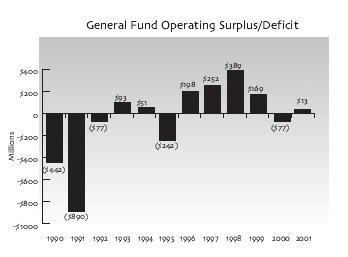
- At the end of Fiscal Year 2001 the sum of $30.7 million was placed in the
state's Rainy Day Fund bringing the fund balance to $594.7 million. This
fund is targeted to hold reserves equal to 5 percent of budgeted General Fund
spending for the year. In 1987, the Rainy Day Fund had a balance of $319.6
million. Three consecutive fiscal years of withdrawals between 1988 and 1990
wiped the fund out.
- With no available Rainy Day Fund reserves by 1991 and a deepening
recession, the state was forced to borrow close to $1 billion in order to
close a budget hole. An expanded revenue base with the introduction of the
income tax in Fiscal Year 1992 and a gradually improving economy allowed the
state to pay off this debt over the six years that followed. Deposits to the
Rainy Day Fund have been made annually since 1995.
- Today, the state's revenue base, dollar reserves, and economic potential
are in a far stronger position than in the early 1990s.
General Fund Revenues:
- In Fiscal Year 2001, total General Fund revenue grew 5.9 percent or $730
million over the prior year. The income tax and the sales tax, which totaled
$7.3 billion in Fiscal Year 2001 and accounted for well over half of all
revenue, increased by 11.4 percent and 0.4 percent respectively from the prior
year.
- The current economic recession began in March 2001, which impacted the
final quarter of Fiscal Year 2001. The downturn reduced sales tax receipts
toward the end of the fiscal year. Income tax receipts were not impacted as
quickly or as severely by the recent downturn.
- Tax reductions over the past six years have reduced revenue by over $1
billion. The tax reductions have been broad based including direct rebates,
lower income tax rates at various income levels, a property tax credit,
substantial reductions in corporation taxes, additional sales tax exemptions,
and hospital tax relief.
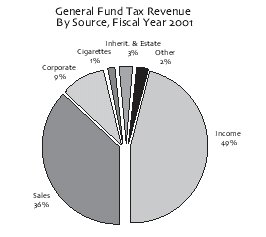
- Not all General Fund revenue comes from taxes. Taxes accounted for 66
percent of the total. Federal payments to the state contributed another 24
percent. The remaining 10 percent of General Fund revenues consisted of casino
and lottery receipts, interest earnings, licenses, fees, investment earnings,
fines and forfeitures, charges and other miscellaneous items.
- Of the major General Fund revenue sources, the income tax has experienced
the highest rate of increase with five-year average annual compounded growth
of 10.1 percent. Strong employment gains coupled with booming financial
markets over the five-year period explain the increase. Of the smaller revenue
sources, casino payments have seen the strongest growth advancing at a
five-year average annual compounded rate of 17.4 percent.
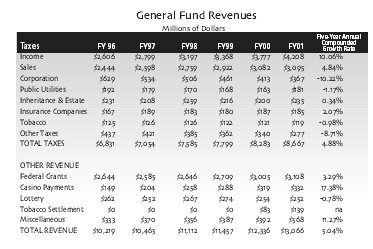
General Fund Expenditures:
- In Fiscal Year 2001, General Fund spending increased by $640 million or 5.2
percent over last fiscal year.
- For the fourth straight year the state's constitutional cap on spending
was lifted under provisions of law. The additional spending required a
declaration of extraordinary circumstances by the Governor. Over the past four
fiscal years the cap has been lifted in order to permit over $1.5 billion in
additional state spending.
- Increases above the average growth rate of 5.2 percent for Fiscal Year 2001
occurred in education, health and hospitals, judicial programs and general
administration; below average growth occurred in human services and regulation
and conservation programs. Looking at growth rates over the five-year period
prior to Fiscal Year 2001, the only areas to experience annual growth rates of
less than 5 percent were human services and education.
- Over the past five fiscal years, General Fund spending has increased at a
compounded annual rate of 5.43 percent.
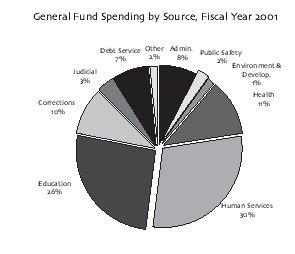
- Two-thirds of all General Fund spending is directed to education, health,
and human services programs. These program areas include education grants to
towns, higher education institutions, mental health and mental retardation
services, nursing homes, income support and health insurance for disabled and
low-income individuals.
Beyond The General Fund - Total Governmental Operations
The state undertakes various activities that do not appear in the General
Fund. These activities include transportation and housing programs, grants to
municipalities for school construction and other needs, loan programs and other
services. When these activities are combined with those of the General Fund, a
more complete picture of state governmental operations emerges.
- Combined governmental operating results for Fiscal Year 2001 show a deficit
of $505 million. On a positive note, this is an improvement of $110 million
from the prior fiscal year.
- Operating deficits of $417 million were incurred in the grants and loan
programs and housing programs. The shortfalls must be covered through debt
financing. Issuing bonds to cover annual grants, loans and housing programs
that have become a part of ongoing state operations is a dubious financial
practice. As can be seen from the debt section that follows, controlling state
borrowing is a major challenge facing government.
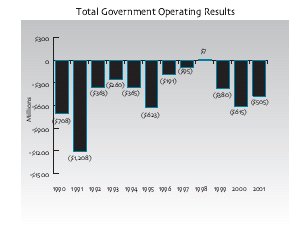
Cumulative Financial Position of the State -The Balance Sheet
In evaluating the state's fiscal health, there is a tendency to focus
exclusively on a single year of state operations. This approach fails to provide
a long-term view of the state's financial position. The balance sheet provides
this perspective. The balance sheet shows total state assets, liabilities, and
fund balances at the close of each fiscal year.
- At the end of Fiscal Year 2001, the General Fund balance sheet displayed a
cumulative GAAP deficit of $782 million. This represents a $107 million
increase over last year.
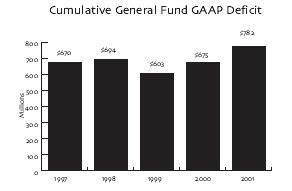
- The main reason for the balance sheet deficit is the state's continued
reliance on an unusual system of budgeting. The state's modified cash
accounting system that is used for budgeting purposes allows some revenues to
be counted before they are earned while some expenditures are not counted for
months after the liability arises. When GAAP corrections to the assets and
liabilities are made a deficit results.
- The GAAP deficit is an important number because those who invest in
Connecticut's bonds and notes review it. If the state's GAAP deficit is
perceived to present investment risk, the interest payments on the debt will
rise costing state taxpayers millions of dollars more.
- The way to improve the state's balance sheet position is clear: adopt
GAAP as the legal basis for state budgeting.
Debt Position
- Connecticut continues to lead the nation in state tax supported debt per
capita. Bonded debt per capita has more than doubled over the past decade
growing to $2,994 at the end of Fiscal Year 2001. This is the amount of money
that every man, women and child would have to pay to eliminate the state's
outstanding debt.
- In Fiscal Year 2001, the state added an additional $503 million to its net
outstanding bonded debt total. Net state bonded debt rose to $10.3 billion by
the end of Fiscal Year 2001.
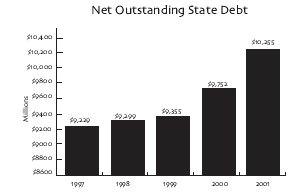
- In Fiscal Year 2001, the state issued $1.327 billion in new debt. Of this
total $816 million was for infrastructure or other assets benefiting future
generations of taxpayers. The remaining $511 million was used to fund on-going
state operating expenses. Bonding for special projects that provide tangible
benefits to future generations is justifiable; bonding for ongoing programs
that should be considered part of normal government operating expenses is not
sound fiscal policy.
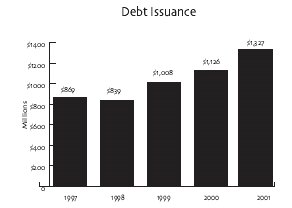
- Large amounts of debt require high annual debt service (principal and
interest) payments. In Fiscal Year 2001, debt service payments totaled $1.34
billion with $790 million paid toward principal and $550 million in interest
payments.
- Debt service is a fixed cost that cannot be quickly adjusted when state
revenue growth slows and budget deficits are projected. In difficult economic
times a high debt load can cripple a state's ability to respond effectively
to the fiscal challenges it faces.
- Bonded debt represents about 60 percent of the state's total long-term
debt obligations. In Fiscal Year 2001, state long-term debt obligations
totaled $17.52 billion.
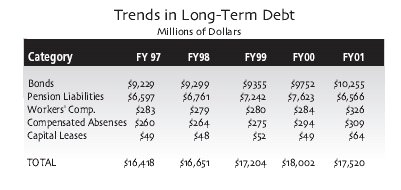
- The decline in total long-term debt since Fiscal Year 2000 is largely due
to exceptional earnings on assets in the pension funds thus reducing the
difference between the amount ultimately payable to employees and the assets
on hand to meet those payments. This difference is known as the unfunded
pension liability.
Table
of Contents | Index of Comptroller's
Reports | Comptroller's Home
Page
![]()